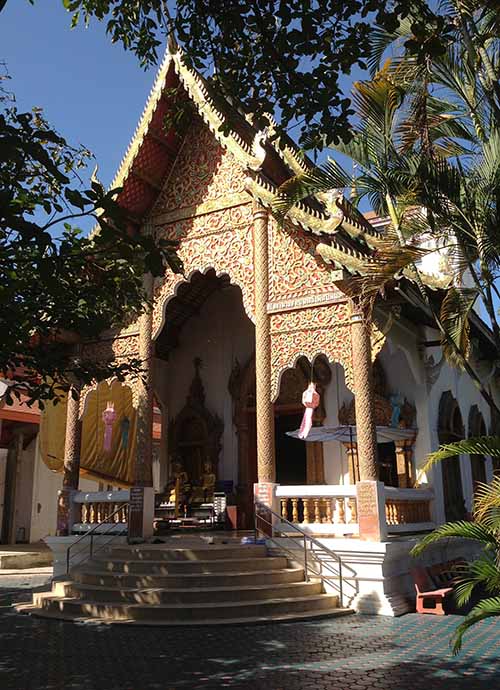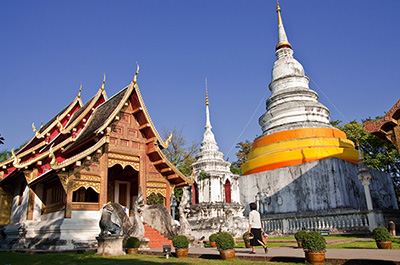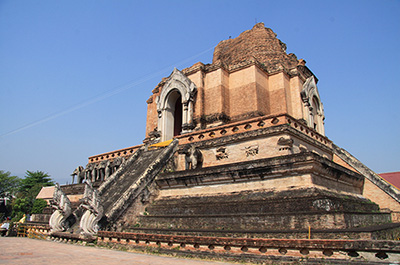
Wat Ou Sai Kham
“Temple of golden sand”
Rebuild 1841
Chiang Mai
The Wat Ou Sai Kham is a small, little visited temple just outside the old walled town center of Chiang Mai. Its name translates to “temple of golden sand”. On the grounds are a viharn, an ubosot, a Ho Trai scripture library and a chedi. The temple advertises its jade Buddha images to attract visitors.
Guarded by Chinthe lions
The temple is surrounded by a wall with Dhamma wheels placed on top. Its main gate is guarded by a large white Chinthe.
Although its founding date is unknown, the temple is believed to more than three centuries old. At one point in time the Wat Ou Sai Kham was abandoned because the size of the village could no longer support it. The temple was rebuild in 1841. The original small chedi was encased into the newly build larger chedi.
Viharn
The front gable of the viharn is adorned with gold on red Lanna style flower motifs. Carvings of Naga serpents embellish the golden barge boards.
Lanna style Buddha image
To the back of the viharn seated on a large pedestal is the Wat Ou Sai Kham’s principal Buddha image in subduing Mara posture, a Lanna style statue cast more than two centuries ago. Around it are several smaller jade images dating to 2003.
Colorful mural paintings
The walls are adorned with mural paintings depicting stories from the Jataka tales, the stories that tell about the previous lives of the Buddha. Behind the principal Buddha image is a mural of a peaceful scene of nature with at its center a large Bodhi tree, the tree the Buddha meditated under when reaching enlightenment.
The story of Phra Sangkachai
In front of the principal Buddha is an image of a fat and bold monk named Phra Sangkachai, sometimes called the laughing Buddha, often found in Chinese Buddhist temples.
Phra Sangkachai was one of the first followers of the Gautama Buddha some 2,500 years ago. According to ancient stories Phra Sangkachai was extremely handsome and attractive which he found was too distracting from his teaching the Dhamma, so he decided to disguise himself as a fat, unattractive monk.
Ubosot
The ubosot, the hall where novice are ordained into monkhood, was build in 1884. The barge boards on the multi tiered roof are adorned with carvings depicting the Naga, a serpent from Buddhist mythology. Its front gable is adorned with detailed carvings of flower motifs. The ubosot is usually locked.
Ho Trai
The very attractive Ho Trai, a wooden building standing on a concrete base, was constructed around 1850. The scripture library stores copies of the Tripitaka, the Buddhist teachings. The Lanna style gable is adorned with intricate carvings, the barge boards inlaid with multi colored glass. The Ho Trai is topped with a golden multi tiered ceremonial umbrella called hti.
Chedi
Adjoining the outer wall stands the Wat Ou Sai Kham’s chedi. Resting on a high square base wit indented corners and a single circular tier is a golden bell topped with a spire. Around the bell’s base are petals of lotus flowers.
Statue of Phra Mae Thorani
Also on the grounds is a statue of Phra Mae Thorani, the Earth Goddess in Buddhism, who drowned the armies of the demon Mara by wringing the waters out of her long hair.
How to get to Wat Ou Sai Kham
The temple is located on Chang Moi Kao road, about 200 meters Northeast of Tha Phae gate just outside the old walled center of Chiang Mai town. The Wat Ou Sai Kham is within walking distance from the center of the old walled town. Alternatively, rent a bicycle or hire a tuk tuk to get there.
Opening hours
The grounds open daily during daylight hours.
Entrance fee
Admission is free.

